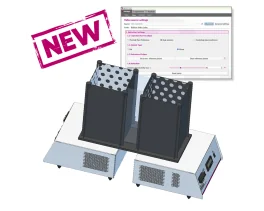Authors
KA Moller, C Aulin, A Baharpoor, CI Svensson
Lab
Department of Physiology & Pharmacology, Karolinska Institutet, Stockholm, Sweden.
Journal
Physiology & Behavior
Abstract
Objective Osteoarthritis (OA) is the most common cause of joint pain. Animal models and relevant assays for measurement of pain-related behaviours are important tools for studies of mechanisms inducing and sustaining pain in OA. The aim of this study was to evaluate two different assessments of weight bearing; stationary and during locomotion, and to explore their feasibility to detect analgesic effects in vivo. Two fundamentally different mouse models of joint arthritis were investigated; surgical transection of the anterior cruciate ligament (ACLT) resulting in destabilization of the joint with subsequent structural deterioration resembling OA, and monoarthritis induced by injection of Complete Freund«s Adjuvant (CFA) into the ankle joint capsule.
Design Mice were subjected to ACLT or CFA injection into the ankle joint. Stationary weight bearing was performed up to twenty weeks after ACLT, and for two weeks after CFA. In addition, mice with CFA-induced monoarthritis were assessed for gait and weight bearing during locomotion, and the effects of an anti-NGF antibody (MEDI578) were tested. End point histopathological analysis was performed in knee joints of ACLT mice, and in mice with ankle joint injection of CFA at eight days after injection.
Results Both the surgical ACLT and CFA-induced monoarthritis reduced stationary weight bearing on the affected paw. The reduction in weight bearing was compensated by all other legs, but differently when stationary compared to during locomotion in the CFA-injected mice. The behavioural effects of ACLT correlated to the structural changes of the joint. In the CFA-induced monoarthritis, showing a massive infiltration of inflammatory cells at 8 days, MEDI578 significantly attenuated the pain-like behaviours.
Conclusions The pain-like behaviour detected is mainly due to inflammation and not to the same degree to structural changes in the joint. Behavioural effects after ACLT were too small for pharmacological evaluation of pain relief. In contrast, the inflammation after CFA injection caused a long-lasting effect on pain-like behaviours such as weight bearing and gait, which could be attenuated by administration of an anti NGF antibody.
BIOSEB Instruments Used
Dynamic Weight Bearing 2.0 (BIO-DWB-DUAL)
Source :
https://www.sciencedirect.com/science/article/abs/pii/S0031938420303930

 Pain - Thermal Allodynia / Hyperalgesia
Pain - Thermal Allodynia / Hyperalgesia Pain - Spontaneous Pain - Postural Deficit
Pain - Spontaneous Pain - Postural Deficit Pain - Mechanical Allodynia / Hyperalgesia
Pain - Mechanical Allodynia / Hyperalgesia Learning/Memory - Attention - Addiction
Learning/Memory - Attention - Addiction Physiology & Respiratory Research
Physiology & Respiratory Research











![Dynamic Weight Bearing 2.0 – Postural Module [Add-on]](https://bioseb.com/733-home_default/dynamic-weight-bearing-20-add-on-postural-module.jpg)
























 Pain
Pain Central Nervous System (CNS)
Central Nervous System (CNS) Neurodegeneration
Neurodegeneration Sensory system
Sensory system Motor control
Motor control Mood Disorders
Mood Disorders Other disorders
Other disorders Muscular system
Muscular system Joints
Joints Metabolism
Metabolism Cross-disciplinary subjects
Cross-disciplinary subjects CONFERENCES & MEETINGS
CONFERENCES & MEETINGS 
